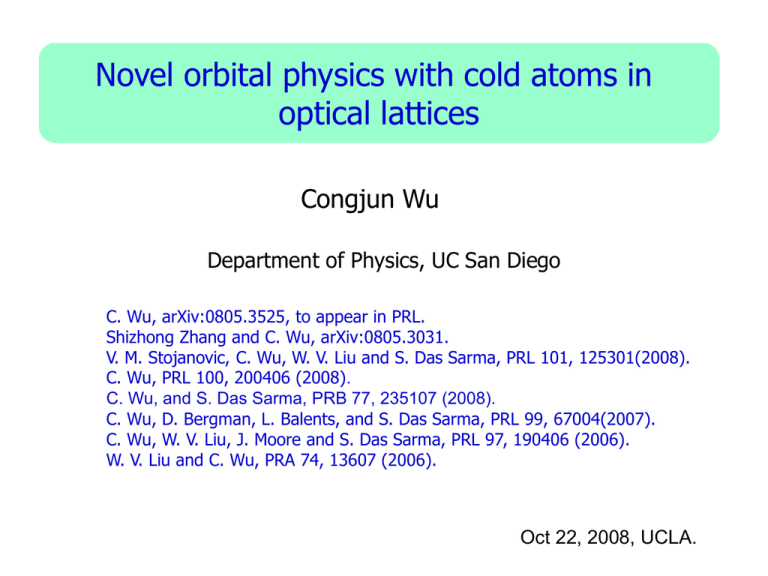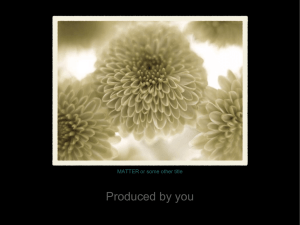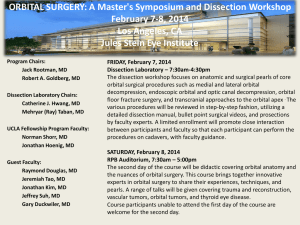Novel Orbital Physics with Cold atoms in Optical lattices
advertisement

Novel orbital physics with cold atoms in
optical lattices
Congjun Wu
Department of Physics, UC San Diego
C. Wu, arXiv:0805.3525, to appear in PRL.
Shizhong Zhang and C. Wu, arXiv:0805.3031.
V. M. Stojanovic, C. Wu, W. V. Liu and S. Das Sarma, PRL 101, 125301(2008).
C. Wu, PRL 100, 200406 (2008).
C. Wu, and S. Das Sarma, PRB 77, 235107 (2008).
C. Wu, D. Bergman, L. Balents, and S. Das Sarma, PRL 99, 67004(2007).
C. Wu, W. V. Liu, J. Moore and S. Das Sarma, PRL 97, 190406 (2006).
W. V. Liu and C. Wu, PRA 74, 13607 (2006).
Oct 22, 2008, UCLA.
Collaborators
L. Balents
UCSB
D. Bergman
Yale
S. Das Sarma
Univ. of Maryland
W. V. Liu
Univ. of Pittsburg
W. C. Lee, H. H. Hung
UCSD
I. Mondragon Shem
J. Moore
Berkeley
Shi-zhong Zhang
UIUC
Many thanks to I. Bloch, L. M. Duan, T. L. Ho, Z. Nussinov, S. C. Zhang
for helpful discussions.
Outline
• Introduction to orbital physics.
New directions of cold atoms: orbital physics in high-orbital
bands; pioneering experiments.
• Bosons: exotic condensate, complex-superfluidity breaking
time-reversal symmetry.
• Fermions: px,y-orbital counterpart of graphene, flat bands
and non-perturbative effects
• Orbital exchange, frustrations, order from disorder, orbital
liquid?.
3
Bose-Einstein condensation
• Bosons in magnetic traps: dilute and weakly interacting
systems.
M. H. Anderson et al., Science 269, 198 (1995)
TBEC ~ 1K
n ~ 1014 cm 3
4
New era of cold atom physics: optical lattices
• Strongly correlated systems.
• Interaction effects are tunable by varying laser intensity.
t
U
t : inter-site tunneling
U: on-site interaction
5
Superfluid-Mott insulator transition
Superfluid
Mott insulator
t<<U
t>>U
87
Rb
Greiner et al., Nature (2001).
6
Research focuses of cold atom physics
• Great success of cold atom physics in the past decade:
BEC,
superfluid-Mott insulator transition,
fermion superfluidity and BEC-BCS crossover … …
• New focus: novel strong correlation phenomena which are
NOT easily accessible in solid state systems.
• New physics of bosons and fermions in high-orbital bands.
Good timing: pioneering experiments;
square lattice (Mainz); double well lattice
(NIST); quasi 1D polariton lattice (stanford).
J. J. Sebby-Strabley, et al., PRA 73, 33605 (2006);
T. Mueller et al., Phys. Rev. Lett. 99, 200405 (2007);
C. W. Lai et al., Nature 450, 529 (2007).
Orbital physics
• Orbital: a degree of freedom
independent of charge and spin.
Tokura, et al., science 288, 462, (2000).
• Orbital band degeneracy and
spatial anisotropy.
• cf. transition metal oxides (d-orbital bands with electrons).
La1-xSr1+xMnO4
LaOFeAs
8
Advantages of optical lattice orbital system
• Solid state orbital systems:
Jahn-Teller distortion quenches orbital
degree of freedom;
only fermions;
correlation effects in p-orbitals are
weak.
• Optical lattices orbital systems:
rigid lattice free of distortion;
both bosons (meta-stable excited
states with long life time) and
fermions;
strongly correlated px,y-orbitals:
stronger anisotropy
s-bond
p-bond
t // t
9
Pumping bosons by Raman transition
• Long life-time: phase coherence.
• Quasi-1d feature in the square
lattice.
py
px
T. Mueller, I. Bloch et al., Phys. Rev.
Lett. 99, 200405 (2007).
10
Lattice polariton condensation in the p-orbital
C. W. Lai et al, Nature 450, 529 (2007)
• Quasi 1D polariton lattice by deposing
metallic strips.
• Condensates at both s-orbital (k=0)
and p-orbital (k=p) states.
Outline
• Introduction.
• Bosons: complex-superfluidity breaking time-reversal
symmetry. New condensates different from Feynman’s
argument of the positive-definitiveness of ground state
wavefunctions.
C. Wu, W. V. Liu, J. Moore and S. Das Sarma, PRL 97, 190406 (2006).
W. V. Liu and C. Wu, PRA 74, 13607 (2006).
Other group’s related work: V. W. Scarola et. al, PRL, 2005; A. Isacsson et. al.,
PRA 2005; A. B. Kuklov, PRL 97, 2006; C. Xu et al., cond-mat/0611620 .
• Fermions: px,y-orbital counterpart of graphene, flat bands
and non-perturbative effects
• Orbital exchange, frustrations, order from disorder, orbital
liquid?.
12
Feynman’s celebrated argument
• The many-body ground state wavefunctions (WF) of boson
systems in the coordinate-representation are positive-definite in
the absence of rotation.
(r1 , r2 ,...rn ) | (r1 , r2 ,...rn ) |
(r1 , r2 ,...rn ) 0
2 n
2
2
H dr1...drn
|
(
r
,...
r
)
|
|
(
r
,..
r
)
|
i 1 n
1
n
2m i 1
| (r1 ,..rn ) |2
V
i j
int
n
U
i 1
ex
(ri )
(r i rj )
• Strong constraint: complex-valued WF positive definite WF;
time-reversal symmetry cannot be broken.
• Feynman’s statement applies to all of superfluid, Mottinsulating, super-solid, density-wave ground states, etc.
New states of bosons beyond Feynman’s argument
• How to bypass this argument to obtain complex-valued
many-body wavefunctions of bosons and spontaneous
breaking of time-reversal symmetry?
Solution 1: Excited (meta-stable) states of bosons:
bosons in higher orbital bands ---- orbital physics of
bosons.
Solution 2: Feynman’s argument does not apply to
Hamiltonians linearly dependent on momentum.
Ground states of spinful bosons with spin-orbit coupling
(e.g. excitons).
C. Wu and I. Mondragon-Shem, ariXiv:0809.3532.
Ferro-orbital interaction for spinless p-orbital bosons
• A single site problem: two orbitals px and py with two spinless
bosons.
V (r1 r2 ) g (r1 r2 )
x2 y 2
Lz 0 :
U g dr | x (r ) |4
polar
1
( px px p y p y ) 0
2
1
2
( x iy ) 2 Lz 2 : { ( p x p x p y p y )
1
( px ip y ) 2 | 0
2
E0 43 U
i
px p y } 0
2
1
axial
i
1
i
E2 23 U
E 2 E0
15
Orbital Hund’s rule for p-orbital spinless bosons
H int
U
2
1 z 2
2
{
n
r r 3 ( Lr ) }
n p x p x p y p y , Lz i ( p x p y p y p x )
• Bosons go into one axial state to save repulsive interaction
energy, thus maximizing orbital angular momentum.
• Axial states (e.g. p+ip) are spatially more
extended than polar states (e.g. px or py).
• cf. Hund’s for electrons; p+ip
superconductors.
1
1
1
polar
i
1
axial
i
16
“Complex” superfluidity with time-reversal symmetry breaking
• Staggered ordering of orbital angular momentum moment in
the square lattice.
t
1
i
i
1
1
i
1
i
t //
1
i
i
i
1
1
1
i
• Time of flight (zero temperature): Bragg peaks located at
fractional values of reciprocal lattice vectors.
p
p
W. V. Liu and C. Wu, PRA 74,
(( m 12 ) , 0) (0, (n 12 ) )
13607 (2006).
a
a
17
“Complex” superfluidity with time-reversal symmetry breaking
• Stripe ordering of orbital angular momentum moment in the
triangular lattice.
i
1
1
i
i
1
i
1
i
1
1
1
i
i
1
1
i
i
i
1
i
1
i
1
i
1
i
1
• Each site behaves like a vortex with long range interaction in the
superfluid state. Stripe ordering to minimize the global vorticity.
C. Wu, W. V. Liu, J. Moore and S. Das Sarma, Phy. Rev. Lett. 97, 190406 (2006).
18
Strong coupling analysis
r3
1
i
• Ising variable for vortex vorticity:
i
1
r1
i
1
r2
16
1
s 1
1
i
1
• The minimum of the effective
flux per plaquette is 1 / 6 .
i
i
i
1
1
2p
1
A
'
r ,r 6 (s r1 s r 2 s r 3 )
r ,r '
1
1
3
1
• The stripe pattern minimizes
the ground state vorticity.
1
6
1
1
6
1
1
1
1
• cf. The same analysis also applies to
p+ip Josephson junction array.
19
Staggered plaquette orbital moment
2p
p
6
1
3
cf. d-density-wave state in high Tc cuprate:
Sudip Chakravarty, R. B. Laughlin, Dirk K. Morr, and Chetan Nayak,
Phys. Rev. B 63, 094503 (2001)
20
Digression: Exciton with Rashba SO coupling in 2D
quantum well
• Excitons: bound states of electrons and holes (heavy).
Effective bosons at low densities below the Mott-limit.
1
Sz
2
jhh, z
3
2
• The SO coupling still survives in the center-of-mass motion.
Let us consider the sector with fixed heavy hole spin.
Kramer doublet: (e , h 2 ), (e , h 2 )
3
R R me* / M ,
M me* mhh*
3
2 2
2
H EX d r {
Vex (r )}
2M
g
R (i ys x i xs y )
2
Ground state condensates: Kramer doublet
• A harmonic trap:
Vex (r ) 12 MT2 r 2
• SO length scale:
1 / k0 /( MR )
l /( MT )
• Half-quantum vortex and spin skyrmion texture
configuration in the strong SO coupling limit.
1/ 2
g (r )ei
f (r )
, 1/ 2
,
i
g ( r )e
f (r )
jz L S
1
2
lk 0 4
Outline
• Introduction.
• Bosons: Complex-superfluidity beyond Feynman’s argument.
• Fermions: px,y-orbital counterpart of graphene, flat
bands and non-perturbative effects.
Shizhong Zhang and C. Wu, arXiv:0805.3031.
C. Wu, and S. Das Sarma, PRB 77, 235107 (2008).
C. Wu, D. Bergman, L. Balents, and S. Das Sarma, PRL 99, 67004(2007).
• Orbital exchange, frustrations, order from disorder, orbital
liquid?.
23
p-orbital fermions in honeycomb lattices
cf. graphene: a surge
of research interest;
pz-orbital; Dirac cones.
pxy-orbital: flat bands;
interaction effects
dominate.
C. Wu, D. Bergman, L. Balents,
and S. Das Sarma, PRL 99,
70401 (2007).
24
px, py orbital physics: why optical lattices?
• pz-orbital band is not a good system for orbital physics.
isotropic within 2D; non-degenerate.
• Interesting orbital physics in the px,
py-orbital bands.
• However, in graphene, 2px and
2py are close to 2s, thus strong
hybridization occurs.
• In optical lattices, px and py-orbital
bands are well separated from s.
1/r-like
potential
2p
2s
1s
p
s
25
Honeycomb optical lattice with phase stability
• Three coherent laser beams polarizing in the z-direction.
G. Grynberg et al., Phys. Rev. Lett. 70, 2249 (1993).
26
Artificial graphene in optical lattices
• Band Hamiltonian (s-bonding) for spinpolarized fermions.
H t t //
[
p
(
r
)
p
(
r
1 1 eˆ1 ) h.c.]
ê2
ê1
B
B
A
r A
[ p (r ) p1 (r eˆ2 ) h.c]
[ p3 (r ) p3 (r eˆ3 ) h.c]
2
p1
p2
3
2
3
2
p x 12 p y
ê3
B
p2
p1
p x 12 p y
p3 p y
p3
27
Flat bands in the entire Brillouin zone!
• Flat band + Dirac cone.
• localized eigenstates.
• If p-bonding is included, the flat
bands acquire small width at the
order of t . Realistic band
structures show t / t // 1%
t // t
p-bond
28
Realistic Band structure with the sinusoidal optical potential
• Excellent band flatness.
px,y-orbital bands
s-orbital bands
2 2
H
V cos( pi r )
2m
i 1~ 3
29
Hubbard model for spinless fermions:
Exact solution: Wigner crystallization in Hubbard
H int
U n p x (r )n p y (r )
r A, B
gapped state
• Close-packed hexagons;
avoiding repulsion.
• The crystalline ordered state is
stable even with small t .
n
1
6
• Particle statistics is irrelevant.
The result is also good for bosons.
Orbital ordering with strong repulsions
n 12
U / t// 10
• Various orbital ordering
insulating states at
commensurate fillings.
• Dimerization at <n>=1/2! Each dimer is an entangled state
of empty and occupied states.
31
Flat-band ferromagnetism (FM)
• FM requires strong repulsion to overcome kinetic energy cost,
and thus has no well-defined weak coupling picture.
• Hubbard-type models cannot give FM unless with the flat band
structure. However, flat band models suffer the stringent
condition of fine-tuned long range hopping, thus are difficult to
realize. A. Mielke and H. Tasaki, Comm. Mat. Phys 158, 341 (1993).
• In spite of its importance, FM has not been paid much attention
in cold atom community because strong repulsive interaction
renders system unstable to the dimer-molecule formation.
• We propose the realistic flat-band ferromagnetism in the porbital honeycomb lattices.
• Interaction amplified by the divergence of DOS. Realization of
FM with weak repulsive interactions in cold atom systems.
Shizhong Zhang and C. Wu, arXiv:0805.3031; .
32
Outline
• Introduction.
• Bosons: new states of matter beyond Feynman’s argument
of the positive-definitiveness of ground state wavefunctions.
Complex-superfluidity breaking time-reversal symmetry.
• Fermions: px,y-orbital counterpart of graphene, flat bands
and non-perturbative effects
• Orbital exchange and frustrations, order from
disorder; orbital liquid?
C. Wu, PRL 100, 200406 (2008).
33
Mott-insulators with orbital degrees of freedom:
orbital exchange of spinless fermion
• Pseudo-spin representation.
1 12 ( px px p y p y ) 2 12 ( px p y p y px ) 3 2i ( px p y p y px )
• No orbital-flip process. Exchange is antiferro-orbital Ising.
J 0
J 0
H ex J 1 (r ) 1 (r xˆ )
J 2t 2 / U
J 2t 2 / U
34
Hexagon lattice: quantum 120 model
• For a bond along the general direction ê .
px , py : eigen-states of eˆ2 cos 2 x sin 2 y
H ex J ( (r ) eˆ2 )( (r eˆ ) eˆ2 )
ê2
px
py
• After a suitable transformation, the Ising quantization axes can
be chosen just as the three bond orientation.
B
1
3
1
3
( 2 1 2 2 )( 2 1 2 2 )
ˆ
H ex J ( (ri ) eij ) ( (rj) eˆij )
1 1
r ,r
A
( 12 1 23 2 )( 12 1 23 2 )
• cf. Kitaev model.
B
B
H kitaev J ( x (r ) x (r e1 )
r
y (r ) y (r e2 ) z (r ) z (r e3 ))
Large S picture: heavy-degeneracy of classic ground states
• Ground state constraint: the two -vectors have the same
projection along the bond orientation.
H ex J {[( (r ) (r )] eˆi }2 J z2 (r )
r ,r
• Ferro-orbital configurations.
or
r
• Oriented loop config: -vectors
along the tangential directions.
36
Global rotation degree of freedom
• Each loop config remains in the ground state manifold by a
suitable arrangement of clockwise/anticlockwise rotation patterns.
• Starting from an oriented loop config with fixed loop locations but
an arbitrary chirality distribution, we arrive at the same unoriented
loop config by performing rotations with angles of 30 , 90 , 150 .
37
“Order from disorder”: 1/S orbital-wave correction
38
Zero energy flat band orbital fluctuations
• Each un-oriented loop has a local
zero energy model up to the
quadratic level.
E 6 JS 2 ( ) 4
• The above config. contains the
maximal number of loops, thus is
selected by quantum fluctuations at
the 1/S level.
• Project under investigation: the quantum limit (s=1/2)? A
very promising system to arrive at orbital liquid state?
39
Summary
Orbital Hund’s rule and complex superfludity of spinless bosons
px,y-orbital counterpart of graphene: flat band and Wigner
crystalization.
Orbital frustration.
i
1
1
i
i
1
1
i
i
i
1
1
1
i
i
i
1
i
1
i
1
1
1
i
i
1
i
1
40
More work
• Orbital analogue of
anomalous quantum Hall
effect – topological
insulators in the p- band.
C. Wu, arXiv:0805.3525, to appear
in PRL.
• Incommensurate
superfluidity in the doublewell lattice of NIST.
V. M. Stojanovic, C. Wu, W. V.
Liu and S. Das Sarma, PRL 101,
125301 (2008).
41








